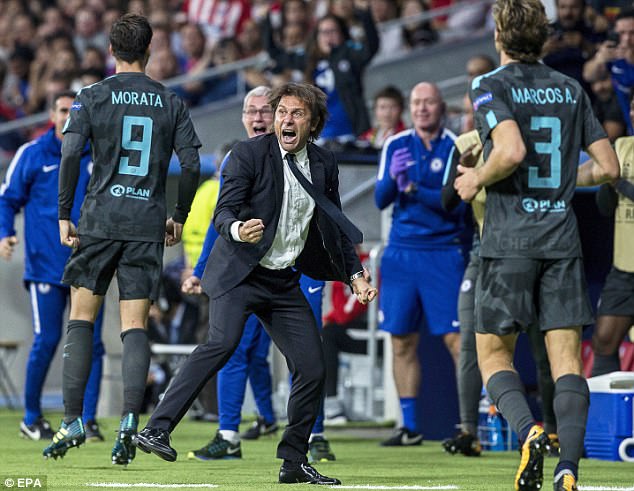Michy Batshuayi’s final kick of Wednesday night’s match at Atletico Madrid’s sparkling new Wanda Metropolitano stadium was the perfect ending to one of the great Chelsea European performances.
It was no more than the visitors deserved, Antonio Conte’s men rightly earning plaudits for outplaying one of Europe’s top sides. But it was no smash and grab win.
Conte knew his title winners had to evolve if they were to compete at Champions League level and fend off a renewed challenge for their Premier League crown.
The Italian’s 3-4-3 formation that took last season by storm, won the league and prompted the vast majority of top division managers to change to three at the back had to be tweaked.
This season’s most impressive side, Manchester City, visit Stamford Bridge on Saturday and will face a similar beast to the one that triumphed in the Spanish capital.
With the three centre-halves and the vaunted wing-backs remaining the same, Conte has shifted to three central midfielders.
Tiemoue Bakayoko – if you haven’t heard his new chant to the tune of Earth Wind & Fire’s disco classic ‘September’ you’re missing out – has replaced Nemanja Matic and bought new vigour to Chelsea’s play in the middle of the park.
His driving forward runs bring to mind a great Chelsea midfielder from the recent past in Michael Essien. Already he has developed a partnership with N’Golo Kante.
With Kante carrying on the tireless work that has played a major role in the destination of the last two Premier League titles, he now has a player next to him equally energetic and direct in his movement. Many felt Matic ponderous in the Blues’ midfield – Bakayoko is anything but.
The duo are quick to move the ball on, adept at passing to each other and are both forward-minded – Kante in particular played very high up the pitch on Wednesday night, pinning back Atletico’s left-hand side of Felipe Luis and Carrasco.
A four-man midfield featuring the two of them does undoubtedly work – and don’t be surprised to see it used frequently against many Premier League teams – but it rules out Chelsea playing one of their most potent attacking weapons.
Cesc Fabregas had arguably his best season in Chelsea colours last term, despite enjoying by far the least playing time. Him coming off the bench added huge dollops of creativity to a central channel which at times lacked it.
Conte admitted he should have been playing more – and this new system gets the best out of the Spaniard. Although the only Chelsea man to be slightly blunted in Madrid, playing alongside Bakayoko and Kante allows Fabregas to concentrate solely on spreading his side’s game and laying on his trademark impeccable chances for team-mates
The game too often passes him by if asked to play as one of just two central midfielders, but this change can bring a new lease of life to his Chelsea career.
At times, noticeably when Bakayoko came on late in the disappointing draw with Arsenal and at times in Madrid, Fabregas has been the deepest Chelsea midfielder – a far cry from the assumed ‘No 10’ role he has taken up before.
It’s possible to draw similarities with how Conte used an aging Andrea Pirlo in Juventus’ midfield.
Pirlo found a late-career renaissance as a deep-lying playmaker given the space to control his side’s use of the ball with the two other central midfielders tasked with winning the ball, providing intense forward momentum and short passing. For Bakayoko and Kante, read Arturo Vidal and Paul Pogba.
However, the real crown jewel in Conte’s 3-5-2 is Chelsea’s star man and Wednesday’s man of the match Eden Hazard.
A free role behind Alvaro Morata allows Hazard to shine as the best player in the Premier League. Time after time he bamboozled one of the most notoriously hard-worn defences in European football.
Many looked upon Hazard’s performance against Atletico as the latest coming of age for the Belgian superstar. If he can tear it up in the Champions League regularly and in the competitions latter stages, the oft-cited Messi and Ronaldo comparisons won’t seem as far away.
Yes, Chelsea are shorn of one of last season’s best creative forces in Pedro, but Hazard’s role and the added texture to midfield makes for an overall more formidable attack.
And crucially, especially as it seemed as if Chelsea could only play one way at times last season, having the Spaniard and Willian in reserve means a switch to the tried and tested 3-4-3 is an easy change.
Having Morata leading the line, too, has helped matters with this new system. Despite not possessing the demonic aggression of Diego Costa (who does?), his movement is more intelligent, his touch is more nuanced and he has proved more than adept at getting on the end of the chances his team-mates are creating from all over the pitch.
Centre-half Cesar Azpilicueta, for example, has laid on four goals for his compatriot, while the partnership with Hazard already looks mouth-watering.
He, too, has it to prove after waiting in the wings at Real Madrid and Juventus.
It combines to provide what Conte thought was most crucial to bolster last season’s runaway champions – evolution, and new threats for the opposition to deal with.
With plaudits raining down on Pep Guardiola’s free-scorers, this is their toughest test yet.














